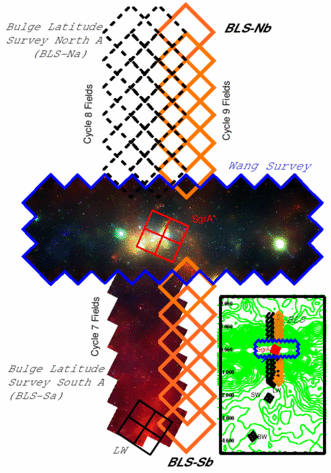|
The ChaMPlane survey is being conducted at the
Harvard-Smithsonian Center for Astrophysics.
|
Bulge Latitude Survey
The ChaMPlane team is conducting a "Bulge Latitude Survey" (BLS) to
measure the latitude distribution of faint X-ray point sources in the
region b = +/- 1.5°, l = +/- 0.35°
centered at l = 0°. The science goals closely connect to
those of our ChaMPlane survey, with the focus on measuring the
large-scale distribution — and hence the nature! — of the
low-luminosity (LX ≤ 1033erg
s-1) point-source population away from the Galactic
Center. Therefore, this survey directly complements the previous
survey of Wang
et al. (2002) for the longitude distribution of sources in the
central Bulge, but also our deep Bulge Windows
Survey of low-extinction regions between 1.5° and 4° from
the Galactic Center.
•Survey coverage
|
|
The BLS is proposed to ultimately be 36 ACIS-I pointings of 15 ks each
above/below the plane at the Galactic Center. In Chandra cycle 7,
two-thirds of the region below the galactic plane were observed
(BLS-Sa); observations of a similar-sized region above the plane
(BLS-Na) are planned for cycle 8 (summer 2007). For cycle 9, we
proposed to complete the full area of the survey (BLS-Sb and
BLS-Nb). This image shows the regions of the BLS survey in relation to
those of the Wang survey, and our Windows survey (inset). The green
contours in the inset follow the visual extinction
AV, going from about AV=1.6 in
Baade's Window to AV ≥ 30 in the Galactic
Center. (click image to enlarge)
|

|
•First results
|
|
This image shows the first results of the BLS: the X-ray (left) and
ISPI near-infrared (right) images of BLS-Sa (covering b =
-0.2 to -1.5° and l = -0.35 to +0.25°) are shown on
the same scale and at the same orientation. Color images were created
by coding RGB channels as follows: 0.3-2 keV, 2-4 keV, 4-8 keV for the
X-ray and K (2.2 μ), H (1.6 μ), J (1.2 μ) for the
near-infrared image. Hard X-ray sources in the Bulge appear blue-ish
(left). Moving down in galactic latitude, diffuse soft emission (red)
becomes visible. In the infrared image, the extinction and dense
molecular clouds thin out over the same distance, hence the higher
star density and bluer appearance in this direction. The infrared
coverage is incomplete as a result of time lost due to bad
weather. (click image to enlarge)
|

|
|
Mosaiced Chandra (0.3-8 keV)
BLS-Sa image (left) and partially completed mosaiced CTIO ISPI (J,H,K)
BLS-Sa image (right). BLS-Na is scheduled for July 2007, and the
remaining ISPI coverage will be obtained then for BLS-Sa as
well. Completion of the full survey is proposed for Chandra Cycle 9
with BLS-Sb/Nb and corresponding ISPI coverage for IR.
|
|
|





